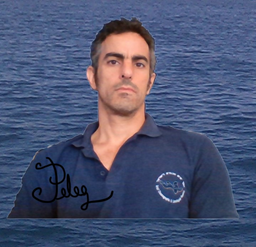
peleg.astrahan@ocean.org.il
Tel: 04 – 6721444 ext. 220
Senior Scientist
Ph.D. 2010 Hebrew University, Israel.
At IOLR since 2013
Research interests:
Marine and freshwater organic matter chemistry.
Among the various studies I conduct are the distribution and fate of molecules such as Mono/Poly Aromatic Hydrocarbons (MAHs & PAHs), polysaccharides, dissolved organic nitrogen, oil degradation products, and pesticides. In addition to these topics, I study the adsorption kinetics of organic pollutants to particulate matter and the potential Endocrine disruptors degradation pathway of Macroalgae.
My laboratory is equipped with unique and highly advanced analytical means, enabling a wide scope of environmental aquatic studies.
I welcome students from all fields to join our special group of researchers, working in Israel and abroad on various topics.
Running projects:
- Volatile Organic Compounds (VOC) sniffers, biochemical fingerprints (sponsored by the Israeli Water Authority).
- Crude oil and Condensate biomagnification and impact at the Israeli Mediterranean coast (sponsored by the Israeli Ministry of Energy).
- Cyanobacteria micro toxins identification and analysis.
- German-Israeli collaboration on the identification of “Hot Spot” polluted particles (sponsored by the BMBF-MOST fund).
- Phenolic EDCs degradation by the seaweed Gracilaria sp.
Selected publications:
Astrahan P., Herut B., Paytan A., Rahav E (2016).The Impact of Dry Atmospheric Depositions on the Sea-Surface Microlayer in the Mediterranean Sea: An Experimental Approach. Frontiers in marine science. 3: article 222. DOI:10.3389/fmars.2016.00222
Astrahan P, Silverman J, Gertner Y, Herut B. (2017).Spatial Distribution and Sources of Organic Matter and Pollutants in The SE Mediterranean (Levantine basin) Deep Water Sediments. Marine Pollution Bulletin. 116 (1-2): 521-527. DOI: 10.1016/j.marpolbul.2017.01.006.
Peleg Astrahan* (2018).Monocyclic Aromatic Hydrocarbons (Phthalates and BTEX) and Aliphatic Components in The SE Mediterranean Costal Sea-Surface Microlayer (SML): Origins and Phase Distribution Analysis. Marine chemistry. 205: 56-69. DOI: 10.1016/j.marchem.2018.07.009
Raveh O, Angel D.L, Astrahan P, Belkin N, Bar-Zeev E, Rahav E. (2019). Phytoplankton response to N-rich well amelioration brines A mesocosm study from the southeastern Mediterranean Sea. Marine Pollution Bulletin. 146: 355-365.
Cohen R, Paikin S, Astrahan P. (2019). Carbapenemase Producing Enterobacteriaceae in River Estuaries and Coastal Water of Netanya, Israel. Open Forum Infectious Diseases. 6 (2): 590–591.
Van der Hal N, Yeruham E, Shukis D, Rilov G, Astrahan P and Angel D.L (2019). Uptake and incorporation of PCBs by eastern Mediterranean rabbitfish that consumed microplastics. marine pollution bulletin. 150.
Cohen R, Paikin S, Rokney A, Rubin‑Blum M and Astrahan P (2020). Multidrug-resistant Enterobacteriaceae in coastal water: an emerging threat. Antimicrobial Resistant Infection Control. 9 (169).
Shai Y, Rubin B.M, Angel L.D, Sisma V.G, Zurel D, Astrahan P, Rahav E (2020). Response of oligotrophic coastal microbial populations in the SE Mediterranean Sea to crude oil pollution; lessons from mesocosm studies. Estuarine, Coastal and Shelf Science Accepted for publication. 249.
Rahav E, Raveh O, Golub Y K, Belkin N, Astrahan P, Maayani M, Tsumi N, Kiro Y, Herut B, Silverman J, Angel L D (2020). Nitrate-enrichment structures phytoplankton communities in the shallow eastern Mediterranean coastal waters. Frontiers in Marine Science, section Marine Front. 7: article 611497.
Astrahan P*, Korzen L, Khanin M, Sharoni Y and Israel A (2021). Seaweeds fast EDC bioremediation: supporting evidence of EE2 and BPA degradation by the red seaweed Gracilaria sp., and a proposed model for the remedy of marine-borne phenol pollutants. Environmental pollution. 278: 116853. DOI: 10.1016/j.envpol.2021.116853. Epub 2021 Mar 2.
Astrahan P*, Lupu Achsa, Leibovichi Edit, Ninio Shira(2023). BTEX and PAHs contributions to Lake Kinneret water, a seasonal-based study of volatile and semi-volatile anthropogenic pollutants in freshwater sources. Environmental science and pollution research. 21: 61145-61159. DOI: 10.1007/s11356-023-26724-9





